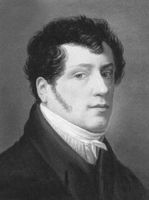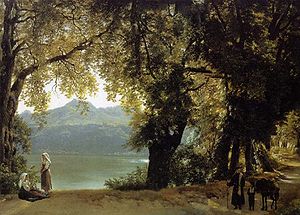
Sylvester Shchedrin
Encyclopedia


Russia
Russia or , officially known as both Russia and the Russian Federation , is a country in northern Eurasia. It is a federal semi-presidential republic, comprising 83 federal subjects...
n landscape painter.
Sylvester Shchedrin was born in St. Petersburg into the family of the famous sculptor Pheodosiy Shchedrin, rector of the Imperial Academy of Arts
Imperial Academy of Arts
The Russian Academy of Arts, informally known as the St. Petersburg Academy of Arts, was founded in 1757 by Ivan Shuvalov under the name Academy of the Three Noblest Arts. Catherine the Great renamed it the Imperial Academy of Arts and commissioned a new building, completed 25 years later in 1789...
. The landscape painter, Semion Shchedrin
Semion Shchedrin
Semyon Fyodorovich Shchedrin was a Russian landscape painter, the uncle and mentor of Sylvester Shchedrin.He was born in St. Petersburg into the family of a life guard. In 1759, he entered the Academy of Arts in St. Petersburg, and in 1765 graduated with a gold medal and grants to study abroad....
, was his uncle. In 1800, Sylvester Shchedrin entered the Imperial Academy of Arts in St. Petersburg, where he studied landscape paintings. Among his teachers were his uncle, Semion Shchedrin, Fedor Alekseev
Fedor Alekseev
Fedor Yakovlevich Alekseev was an early Russian painter of landscape art.After training in the Saint Petersburg Imperial Academy of Arts, he spent three years in Venice studying the works of famous French and Italian landscape painters.Returning to Saint Petersburg to work, his popularity grew...
, M.M. Ivanov and Thomas de Thomon.. In 1811 he graduated with several awards including the Large Gold Medal for his painting View from Petrovsky Island that gave him a scholarship to study abroad.

Napoleonic Wars
The Napoleonic Wars were a series of wars declared against Napoleon's French Empire by opposing coalitions that ran from 1803 to 1815. As a continuation of the wars sparked by the French Revolution of 1789, they revolutionised European armies and played out on an unprecedented scale, mainly due to...
. In Italy, he studied the old masters in Rome
Rome
Rome is the capital of Italy and the country's largest and most populated city and comune, with over 2.7 million residents in . The city is located in the central-western portion of the Italian Peninsula, on the Tiber River within the Lazio region of Italy.Rome's history spans two and a half...
; goes to Naples
Naples
Naples is a city in Southern Italy, situated on the country's west coast by the Gulf of Naples. Lying between two notable volcanic regions, Mount Vesuvius and the Phlegraean Fields, it is the capital of the region of Campania and of the province of Naples...
to paint watacolrs ordered by Grand Duke
Grand Duke
The title grand duke is used in Western Europe and particularly in Germanic countries for provincial sovereigns. Grand duke is of a protocolary rank below a king but higher than a sovereign duke. Grand duke is also the usual and established translation of grand prince in languages which do not...
Mikhail Pavlovich of Russia; then return back to Rome. The biggest achievement of that period was New Rome. castle Sant'Angelo (1823) It was such a great success that he has painted 8-10 variations of the painting, each from a slightly different angle and with different details. His pension ended in 1823, but he decided to stay in abroad as a freelance painter. In 1825 he finished his work Lake of Albano that was a new step in his movement to the natural composition. In this painting he relaxed the boundary between subject and background, moved from using the formal colors.
Shchedrin had many commissions and grew to become a well-known artist in Italy. He lived in Rome
Rome
Rome is the capital of Italy and the country's largest and most populated city and comune, with over 2.7 million residents in . The city is located in the central-western portion of the Italian Peninsula, on the Tiber River within the Lazio region of Italy.Rome's history spans two and a half...
and Naples
Naples
Naples is a city in Southern Italy, situated on the country's west coast by the Gulf of Naples. Lying between two notable volcanic regions, Mount Vesuvius and the Phlegraean Fields, it is the capital of the region of Campania and of the province of Naples...
, working en plein air
En plein air
En plein air is a French expression which means "in the open air", and is particularly used to describe the act of painting outdoors.Artists have long painted outdoors, but in the mid-19th century working in natural light became particularly important to the Barbizon school and Impressionism...
, drawing bays and cliffs and views of small towns and fishermen villages. One of his favorite motifs were terraces in vines with a view of the sea. Referred as the images of the "Midday Paradis". At the end of the 1820s, Shchedrin began to draw nighttime uneasy, almost nightmarish landscapes, which may have been inspired from his gradually declining health. He died in Sorrento
Sorrento
Sorrento is the name of many cities and towns:*Sorrento, Italy*Sorrento, Florida, United States*Sorrento, Louisiana, United States*Sorrento, Maine, United States*Sorrento, Victoria, a township on the Mornington Peninsula, Victoria, Australia...
in 1830. In a sense works of Shchedrin concluded the whole period of developing of Russian art and started the new period in its development.

Posillipo
Posillipo is a residential quarter of Naples, southern Italy, located along the northern coast of the Gulf of Naples; it is called Pusilleco in the Neapolitan language.-Geography:...
school. Many of his works are in Italian museums while some were returned to Russia. Shchedrin's letters full of important artistic observations were published as a book (Shchedrin Letters from Italy) in 1932 and reprinted in 1978.

